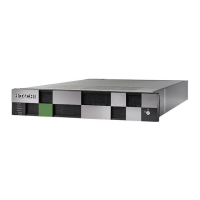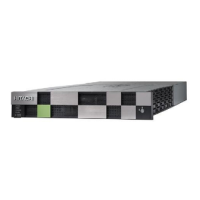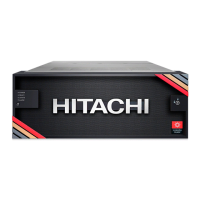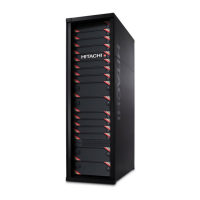Do you have a question about the Hitachi VSP G200 and is the answer not in the manual?
Identifies target readers and required prior knowledge for understanding this document.
Explains terminology and typographic conventions used throughout the document.
Provides contact information and resources for technical support and community assistance.
Provides a high-level view of the storage system management software architecture and access points.
Outlines the different methods and tools used for system administration tasks on VSP Gx00 and Fx00 models.
Details the process and requirements for installing Storage Advisor on Linux or via virtual appliance.
Explains how to set up a management client and log in to Device Manager - Storage Navigator.
Describes the process of associating storage systems with Storage Advisor and initial configuration steps.
Explains how to perform administration tasks using the maintenance utility accessed via HDvM-SN, SMU, or management software.
Covers tasks like configuring block storage, enabling port security, and adding fabric switches using Hitachi Storage Advisor.
Details how to set storage system information, manage configuration files, and perform other administrative tasks.
Explains how to change date/time, network settings, and manage ports using the maintenance utility.
Details the required roles for operating the maintenance utility and setting up user accounts.
Describes how to define users, user groups, and their permissions for managing the storage system effectively.
Explains user roles, permissions, and groups for managing storage systems via NAS Manager.
Explains how to configure firewalls to allow management client and SVP connections.
Covers the use of SSL and HCS certificates for secure, encrypted connections between SVP and storage system.
Details how to configure authentication servers (LDAP, RADIUS, Kerberos) for user login.
Explains how to view alert email, Syslog, and SNMP trap messages in Device Manager - Storage Navigator.
Explains how to configure email, Syslog, and SNMP alerts for monitoring system status and events.
Describes the four types of license keys: Permanent, Term, Temporary, and Emergency.
Provides instructions on installing, enabling, disabling, and uninstalling block and file license keys.
Details how to configure audit log settings, including setting up syslog servers and exporting logs.
Explains how to view configuration reports in table, graphical, and CSV formats.
Describes how to download dump files for troubleshooting and system configuration checks.
Explains how system option modes (SOMs) tailor the storage system to specific customer operating requirements.
Identifies target readers and required prior knowledge for understanding this document.
Explains terminology and typographic conventions used throughout the document.
Provides contact information and resources for technical support and community assistance.
Provides a high-level view of the storage system management software architecture and access points.
Outlines the different methods and tools used for system administration tasks on VSP Gx00 and Fx00 models.
Details the process and requirements for installing Storage Advisor on Linux or via virtual appliance.
Explains how to set up a management client and log in to Device Manager - Storage Navigator.
Describes the process of associating storage systems with Storage Advisor and initial configuration steps.
Explains how to perform administration tasks using the maintenance utility accessed via HDvM-SN, SMU, or management software.
Covers tasks like configuring block storage, enabling port security, and adding fabric switches using Hitachi Storage Advisor.
Details how to set storage system information, manage configuration files, and perform other administrative tasks.
Explains how to change date/time, network settings, and manage ports using the maintenance utility.
Details the required roles for operating the maintenance utility and setting up user accounts.
Describes how to define users, user groups, and their permissions for managing the storage system effectively.
Explains user roles, permissions, and groups for managing storage systems via NAS Manager.
Explains how to configure firewalls to allow management client and SVP connections.
Covers the use of SSL and HCS certificates for secure, encrypted connections between SVP and storage system.
Details how to configure authentication servers (LDAP, RADIUS, Kerberos) for user login.
Explains how to view alert email, Syslog, and SNMP trap messages in Device Manager - Storage Navigator.
Explains how to configure email, Syslog, and SNMP alerts for monitoring system status and events.
Describes the four types of license keys: Permanent, Term, Temporary, and Emergency.
Provides instructions on installing, enabling, disabling, and uninstalling block and file license keys.
Details how to configure audit log settings, including setting up syslog servers and exporting logs.
Explains how to view configuration reports in table, graphical, and CSV formats.
Describes how to download dump files for troubleshooting and system configuration checks.
Explains how system option modes (SOMs) tailor the storage system to specific customer operating requirements.
| Model | VSP G200 |
|---|---|
| Data Reduction Features | Deduplication, Compression |
| Processor | Intel Xeon |
| Operating System | Hitachi Storage Virtualization Operating System (SVOS) |
| Humidity | 20% to 80% non-condensing |
| Category | Storage |
| Drive Types Supported | SSD |
| Host Interfaces | Fibre Channel, iSCSI, FCoE |
| RAID Levels | RAID 5, RAID 6 |
| Connectivity | 16 Gb FC |
| Management Software | Hitachi Command Suite |
| Power Supply | Redundant |
| Form Factor | Rackmount |
| Operating Temperature | 5°C to 35°C |












